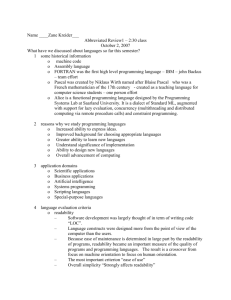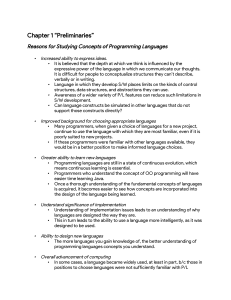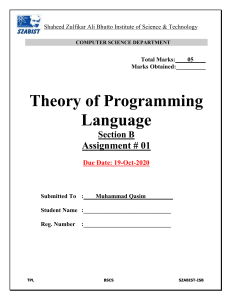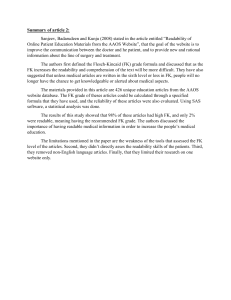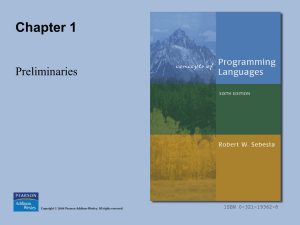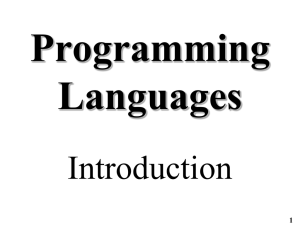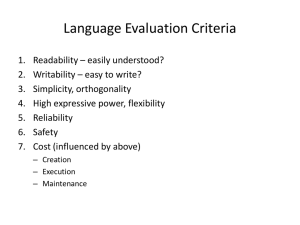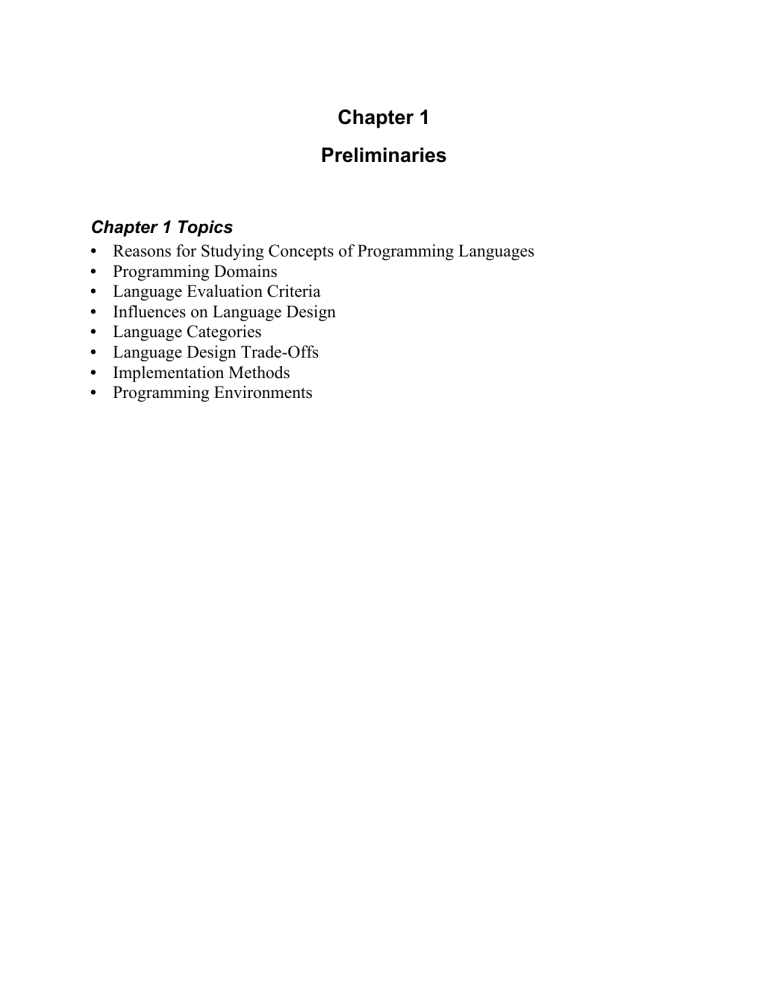
Chapter 1
Preliminaries
Chapter 1 Topics
• Reasons for Studying Concepts of Programming Languages
• Programming Domains
• Language Evaluation Criteria
• Influences on Language Design
• Language Categories
• Language Design Trade-Offs
• Implementation Methods
• Programming Environments
Chapter 1
Preliminaries
Reasons for Studying Concepts of Programming Languages
•
Increased ability to express ideas.
• It is believed that the depth at which we think is influenced by the expressive
power of the language in which we communicate our thoughts.
• It is difficult for people to conceptualize structures they can’t describe, verbally
or in writing.
• Language in which they develop software places limits on the kinds of control
structures, data structures, and abstractions they can use.
• Awareness of a wider variety of programming language features can reduce
such limitations in software development.
• Can language constructs be simulated in other languages that do not support those
constructs directly? Associative arrays in Perl vs. C
•
Improved background for choosing appropriate languages
• Many programmers, when given a choice of languages for a new project, continue
to use the language with which they are most familiar, even if it is poorly suited to
new projects.
• If these programmers were familiar with other languages available, they would be
in a better position to make informed language choices.
•
Greater ability to learn new languages
• Programming languages are still in a state of continuous evolution, which means
continuous learning is essential.
• Programmers who understand the concept of object oriented programming will
have easier time learning Java.
• Once a thorough understanding of the fundamental concepts of languages is
acquired, it becomes easier to see how concepts are incorporated into the design
of the language being learned.
•
Understand significance of implementation
• Understanding of implementation issues leads to an understanding of why
languages are designed the way they are.
• This in turn leads to the ability to use a language more intelligently, as it was
designed to be used.
• For example, programmers who know little about how recursion is implemented
often do not know that a recursive algorithm can be far slower than an equivalent
iterative algorithm.
•
Ability to design new languages
• The more languages you gain knowledge of, the better understanding of
programming languages concepts you understand.
•
Overall advancement of computing
• In some cases, a language became widely used, at least in part, because those in
positions to choose languages were not sufficiently familiar with programming
language concepts.
• Many believe that ALGOL 60 was a better language than Fortran; however,
Fortran was most widely used. It is attributed to the fact that the programmers
and managers didn’t understand the conceptual design of ALGOL 60.
Programming Domains
•
•
•
•
•
Scientific applications
– In the early 40s computers were invented for scientific applications.
– The applications require large number of floating point computations.
– Fortran was the first language developed scientific applications.
– ALGOL 60 was intended for the same use.
Business applications
– The first successful language for business was COBOL.
– Business languages are characterized by facilities for producing elaborate
reports, precise ways of describing and storing decimal numbers and character
data, and the ability to specify decimal arithmetic operations.
– The arrival of PCs started new ways for businesses to use computers.
– Spreadsheets and database systems were developed for business.
Artificial intelligence
– Symbolic rather than numeric computations are manipulated.
– Symbolic computation is more suitably done with linked lists than arrays.
– LISP was the first widely used AI programming language.
– An alternative approach to AI applications: Prolog
– Scheme, a dialect of LISP
Systems programming
– The OS and all of the programming supports tools are collectively known as its
system software.
– Need efficiency because of continuous use.
– A language for this domain must provide fast execution. Furthermore, it must
have low-level features that allow the software interfaces to external devices to
be written.
– The UNIX operating system is written almost entirely in C.
Scripting languages
– Put a list of commands, called a script, in a file to be executed.
– The language, named sh (for shell), began as a small collection of commands that
were interpreted as calls to system subprograms that performed utility functions,
such as file management and simple file filtering.
– awk, another scripting language, began as a report-generation language but later
became a more general-purpose language.
– The Perl language, developed by Larry Wall, was originally a combination of sh
and awk.
– The use of Perl rose dramatically, primarily because it is a nearly ideal language
for Common Gateway Interface (CGI) programming.
– JavaScript (Flanagan, 1998) is a scripting language developed by Netscape.
– JavaScript is used mostly as a client-side scripting language.
– JavaScript is embedded in HTML documents and is interpreted by a browser
that finds the code in a document that is being displayed.
–
•
PHP is a scripting language used on Web server systems. Its code is embedded
in HTML documents. The code is interpreted on the server before the document
is sent to a requesting browser.
Special-purpose languages
– A host of special-purpose languages have appeared over the past 40 years.
– They range from RPG, which is used to produce business reports, to APT, which
is used for instructing programmable machine tools, to GPSS, which is used for
system simulation.
– This book does not discuss special-purpose language.
Language Evaluation Criteria
Readability
•
•
•
•
•
The most important criteria for judging a programming language is the ease with which
programs can be read and understood.
Language constructs were designed more from the point of view of the computer than the
users.
Because ease of maintenance is determined in large part by the readability of programs,
readability became an important measure of the quality of programs and programming
languages. The result is a crossover from focus on machine orientation to focus on human
orientation.
The most important criterion “ease of use”
Overall simplicity “Strongly affects readability”
– Too many features make the language difficult to learn. Programmers tend to learn a
subset of the language and ignore its other features.
– Multiplicity of features is also a complicating characteristic “having more than one
way to accomplish a particular operation.” Ex “Java”:
count = count + 1
count += 1
count ++
++count
–
Although the last two statements have slightly different meaning from each other and
from the others, all four have the same meaning when used as stand-alone
expressions.
– Operator overloading where a single operator symbol has more than one meaning.
– Although this is a useful feature, it can lead to reduced readability if users are allowed
to create their own overloading and do not do it sensibly.
– Most assembly language statements are models of simplicity.
– This very simplicity, however, makes assembly language programs less readable.
Because they lack more complex control statements.
•
Orthogonality
– Makes the language easy to learn and read.
– A relatively small set of primitive constructs can be combined in a relatively small
number of ways to build the control and data structures of the language.
– Every possible combination is legal and meaningful.
– The more orthogonal the design of a language, the fewer exceptions the language
rules require.
– Example: In C language, parameters are passed by value, unless they are arrays, in
which they are, in effect, passed by reference (because the appearance of an array
name without a subscript in a C program is interpreted to be the address of the
array’s first element).
– Example: Adding two 32-bit integer values that reside in either memory or registers
and replacing on of two values with the sum.
• The IBM mainframes have two instructions:
A
Reg1, memory_cell
//Reg1 <- contents (Reg1) + contents(memory_cell)
AR
Reg1, Reg2
//Reg1 <- contents (Reg1) + contents(Reg2)
where Reg1 and Reg2 represent registers.
•
–
–
•
The VAX addition instruction for 32-bit integer value is:
ADDL
operand_1, operand_2
//operand_2 <- contents(operand_1) + contents(operand_2)
In this case, either operand can be a register or a memory cell.
• The VAX instruction design is orthogonal in that a single instruction can use
either registers or memory cell as the operands. The IBM design is not
orthogonal.
Too much orthogonality can also cause problems.
Example: the most orthogonal programming language is ALGOL 68. Every
language construct in ALGOL 68 has a type, and there are no restrictions on those
types.
• For example, a conditional can appear as the left side of an assignment, along
with declarations and other assorted statements, as long as the result is an
address.
• This form of orthogonality leads to unnecessary complexity.
Control Statements
– It became widely recognized that indiscriminate use of goto statements severely
reduced program readability.
– Example: Consider the following nested loops written in C
while (incr < 20)
{
while (sum <= 100
{
sum += incr;
}
incr++;
}
if C didn’t have a loop construct, this would be written as follows:
loop1:
if (incr >= 20) go to out;
loop2:
if (sum > 100) go to next;
sum += incr;
go to loop2;
next:
incr++;
go to loop1:
out:
–
–
•
Basic and Fortran in the early 1970s lacked the control statements that allow strong
restrictions on the use of gotos, so writing highly readable programs in those
languages was difficult.
Since then, languages have included sufficient control structures. The control
statement design of a language is now a less important factor in readability than it
was in the past.
Data Types and Structures
– The presence of adequate facilities for defining data types and data structures in a
language is another significant aid to reliability.
– Example: suppose a numeric type is used for an indicator flag because there is no
Boolean type in the language. In such a language, we might have an assignment such
as
timeout = 1
•
Whose meaning is unclear, whereas in a language that includes Boolean types
we would have
timeout = true
•
Syntax Considerations
– The syntax of the elements of a language has a significant effect on readability.
– The following are examples of syntactic design choices that affect readability:
• Identifier forms: Restricting identifiers to very short lengths detracts from
readability.
– Example: In Fortan 77, identifiers can have six characters at most.
– Example: ANSI BASIC (1978) an identifier could consist only of a
single letter or a single letter followed by a single digit.
• Special Words: Program appearance and thus program readability are strongly
influenced by the forms of a language’s special words (while, class, for).
– Example: C uses braces for pairing control structures. It is difficult to
determine which group is being ended.
– Example: Fortran 95 and Ada allows programmers to use special
names as legal variable names. Ada uses end if to terminate a selection
construct, and end loop to terminate a loop construct.
• Form and Meaning: Designing statements so that their appearance at least
partially indicates their purpose is an obvious aid to readability.
• Semantic should follow directly from syntax, or form.
– Example: In C the use of static depends on the context of its
appearance.
– If used as a variable inside a function, it means the variable is created
at compile time.
–
If used on the definition of a variable that is outside all functions, it
means the variable is visible only in the file in which its definition
appears. It is not exported from that file.
Writability
•
•
•
•
It is a measure of how easily a language can be used to create programs for a chosen
problem domain.
• Most of the language characteristics that affect readability also affect writability.
Simplicity and orthogonality
– A smaller number of primitive constructs and a consistent set of rules for
combining them (that is, orthogonality) is much better than simply having a large
number of primitives.
– A programmer can design a solution to a complex problem after learning only a
simple set of primitive constructs.
Support for abstraction
– Abstraction means the ability to define and then use complicated structures or
operations in ways that allow many of the details to be ignored.
– Programming languages can support two distinct categories of abstraction,
process and data.
– A simple example of process abstraction is the use of subprogram to implement
a sort algorithm that is required several times in a program. Without the
subprogram, the sort code would have to be replicated in all places where it was
needed.
– As an example of data abstraction, consider a binary tree that stores integer
data in its nodes. In Fortran 77, three parallel integer arrays, where two of these
integers are used as subscripts to specify offspring nodes. In C++ and Java, theses
trees can be implemented by using an abstraction of a tree node in the form of a
simple class with two pointers (or references) and an integer.
Expressivity
– It means that a language has relatively convenient, rather than cumbersome, ways
of specifying computations.
–
Ex: ++count
⇔
count = count + 1 // more convenient and shorter
Reliability
•
•
•
•
•
A program is said to be reliable if it performs to its specifications under all conditions.
Type checking: is simply testing for type errors in a given program, either by the
compiler or during program execution.
– The earlier errors are detected, the less expensive it is to make the required
repairs. Java requires type checking of nearly all variables and expressions at
compile time.
Exception handling: the ability to intercept run-time errors, take corrective measures,
and then continue is a great aid to reliability.
Aliasing: it is having two or more distinct referencing methods, or names, for the same
memory cell. In C, union members and pointers set to point to the same variable.
– It is now widely accepted that aliasing is a dangerous feature in a language.
Readability and writability: Both readability and writability influence reliability.
Cost
–
Categories
– Training programmers to use language
– Writing programs
– Compiling programs
– Executing programs
– Language implementation system “Free compilers is the key, success of Java”
– Reliability, does the software fail?
– Maintaining programs: Maintenance costs can be as high as two to four times as
much as development costs.
– Portability “standardization of the language”
– Generality (the applicability to a wide range of applications)
Influences on Language Design
•
•
Computer architecture: Von Neumann
We use imperative languages, at least in part, because we use von Neumann machines
– Data and programs stored in same memory
– Memory is separate from CPU
– Instructions and data are piped from memory to CPU
– Results of operations in the CPU must be moved back to memory
– Basis for imperative languages
• Variables model memory cells
• Assignment statements model piping
• Iteration is efficient
Programming methodologies
•
•
•
Late 1960s: Procedure-oriented
– People efficiency became important; readability, better control structures
– Structured programming
– Top-down design and step-wise refinement
Late 1970s: Procedure-oriented to data-oriented
– data abstraction
early 1980s: Object-oriented programming
Language Categories
•
•
•
•
Imperative
– Central features are variables, assignment statements, and iteration
– C, Pascal
Functional
– Main means of making computations is by applying functions to given parameters
– LISP, Scheme
Logic
– Rule-based
– Rules are specified in no special order
– Prolog
Object-oriented
– Encapsulate data objects with processing
– Inheritance and dynamic type binding
– Grew out of imperative languages
– C++, Java
Language Design Trade-offs
•
•
Reliability vs. cost of execution
Example: C programs execute faster than semantically equivalent Java programs,
although Java programs are more reliable.
– Java demands all references to array elements be checked for proper indexing but
that leads to increased execution costs.
– C does not require index range checking
Implementation Methods
•
•
•
The major methods of implementing programming languages are compilation, pure
interpretation, and hybrid implementation
– Compilation: Programs are translated into machine language
– Pure Interpretation: Programs are interpreted by another program known as an
interpreter
– Hybrid Implementation Systems: A compromise between compilers and pure
interpreters
The operating system and language implementation are layered over machine interface
of a computer.
These layers can be thought of as virtual computers, providing interfaces to the user at
higher levels
Figure 1.2 Layered View of Computer
Layered interface of virtual computers, provided by a typical computer system
Compilation
•
•
•
•
Translate high-level program (source language) into machine code (machine language)
Slow translation, fast execution
C, COBOL, and Ada are by compilers.
Compilation process has several phases:
– lexical analysis: converts characters in the source program into lexical units
• The lexical units of a program are identifiers, special words operators, and
punctuation symbols.
– Syntax analysis: transforms lexical units into parse trees
• These parse trees represent the syntactic structure of program
– Semantics analysis: generate intermediate code
• Intermediate languages sometimes look very much like assembly
languages and in fact sometimes are actual assembly language.
– Symbol table: the type and attribute information of each user-defined name in
the program
– Optimization: improve programs by making them smaller or faster or both
– Code generation: machine code is generated
Figure 1.3 The Compilation Process
•
Fetch-execute-cycle (on a von Neumann architecture)
initialize the program counter
repeat forever
fetch the instruction pointed by the counter
increment the counter
decode the instruction
execute the instruction
end repeat
•
Von Neumann Bottleneck
– The speed of the connection between a computer’s memory and its processor
determines the speed of a computer.
– Instructions often can be executed a lot faster than they can be moved to the
processor for execution.
– This connection speed is called the von Neumann bottleneck; it is the primary
limiting factor in the speed of computers
Pure Interpretation
•
•
•
•
•
Programs are interpreted by another program called an interpreter, with no translation.
Advantage: easy implementation of many source-level debugging operations, because all
run-time error messages can refer to source-level units.
Disadvantage: slower execution (10 to 100 times slower than compiled programs)
Bottleneck: Statement decoding, rather than the connection between the processor and
memory, is the bottleneck of a pure interpreter.
Significant comeback with some Web scripting languages (e.g., JavaScript and PHP).
Figure 1.4 Pure Interpretation Process
Hybrid Implementation Systems
•
•
•
•
A compromise between compilers and pure interpreters
A high-level language program is translated to an intermediate language that allows
easy interpretation
Faster than pure interpretation
Examples:
– Perl programs are partially compiled to detect errors before interpretation
– Java were hybrid: the intermediate form, byte code, provides portability to any
machine that has a byte code interpreter and a run-time system (together, these are
called Java Virtual Machine)
Figure 1.5 Hybrid Implementation System
Programming Environments
•
•
•
•
The collection of tools used in software development
UNIX
– An older operating system and tool collection
Borland JBuilder
– An integrated development environment for Java
Microsoft Visual Studio.NET
– A large, complex visual environment
– Used to program in C#, Visual BASIC.NET, Jscript, J#, or C++
Summary
•
•
•
The study of programming language is valuable for a number of important reasons:
– Increases our capacity to use different constructs in writing programs
– Enables us to choose languages for projects more intelligently
– Makes learning new languages easier
Among the most important criteria for evaluating languages are:
– Readability
– Writability
– Reliability
– Overall cost
The major methods of implementing program languages are
– Compilation
– Pure interpretation
– Hybrid implementation
